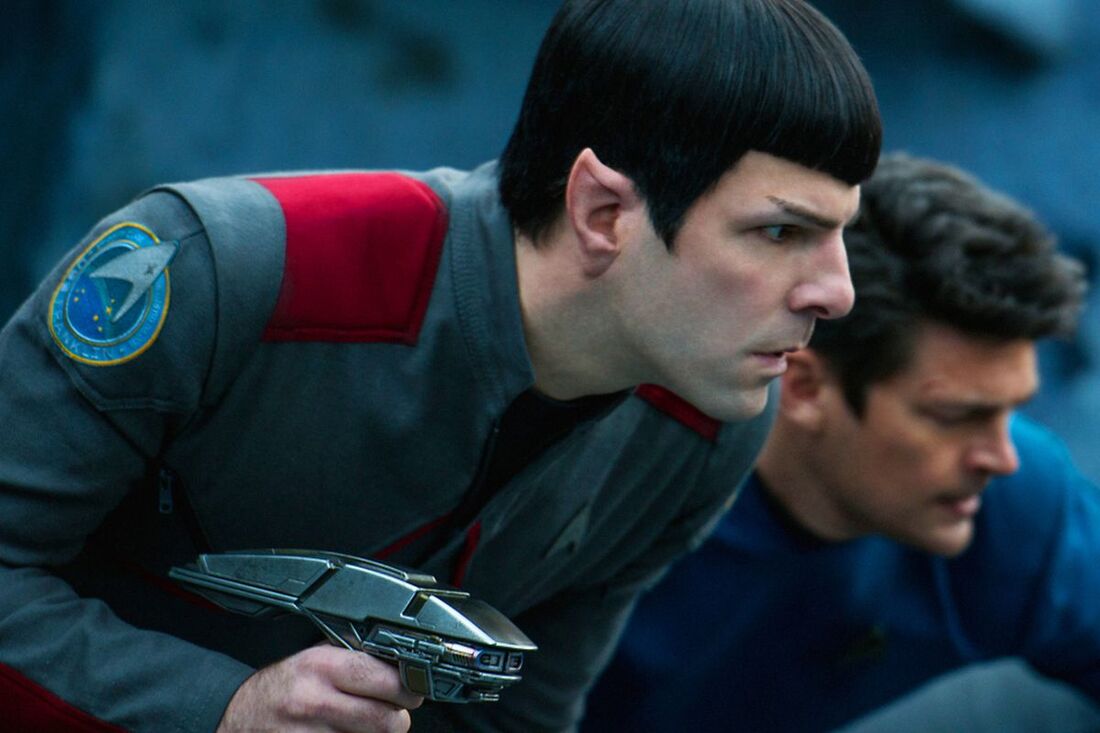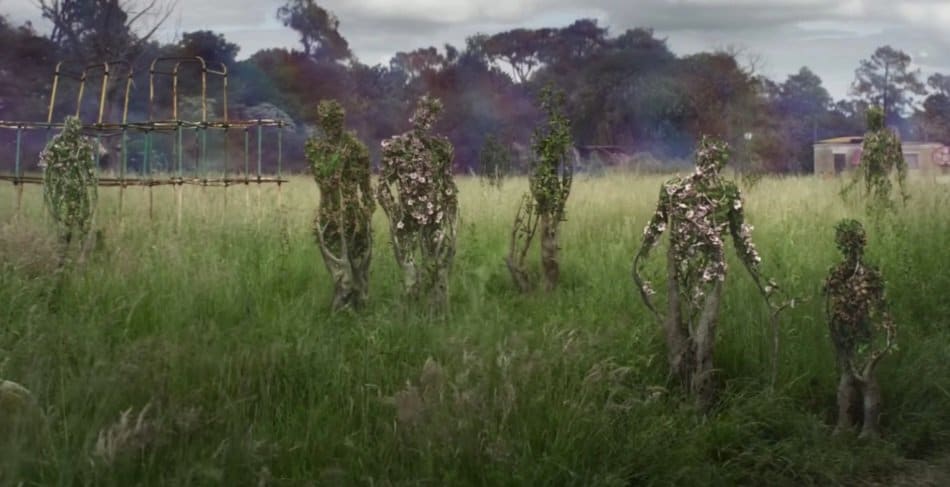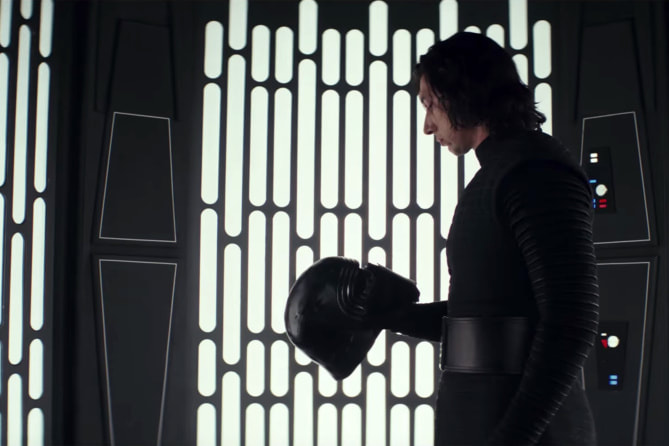|
Rick and Morty’s been cranking out episodes for years, and amidst its fast food cross-promotions and raunchy brand of science fiction, Dan Harmon and Justin Roiland have made the ur-multiverse text. They seem to be the only film/TV writers that are engaging with what it would mean if infinite possibilities existed and were within one’s grasp. Marvel’s attempts to do anything with the concept look shameful and pathetic next to Rick and Morty’s imagination. Daniel Kwan and Daniel Scheinert, otherwise known as Daniels, come closest with their gonzo sci-fi epic Everything Everywhere All At Once, a film so packed with large- and small-scale ideas that if one’s not working, the viewer need only wait a minute for a new one to be introduced. This kitchen sink approach makes for a singular moviewatching experience, though the takeaway still comes off as less-than if the viewer’s head contains dozens of episodes of a portal-gun wielding scientist and his grandson cavorting through the multiverse.
0 Comments
An imagined dystopian past informs the dystopian present in Mark Romanek’s heartbreaker Never Let Me Go. Adapted from Kazuo Ishiguro’s acclaimed novel, the film begins with text informing the viewer of an imagined medical breakthrough and a cut to a grim Tommy (Andrew Garfield) on an operating table while Kathy (Carey Mulligan) watches in mournful anticipation. However, we quickly learn in flashbacks to their creepy boarding school that they aren’t the beneficiaries of this breakthrough, but the breakthrough themselves. Tommy is prone to uncontrollable fits of impotent rage, both in his youth and his adulthood. Romanek’s tale of unbreakable caste bonds and the humanity that can’t help but grow in spite of it is its own primal scream, although we see that the boarding school did such an effective job that most students don’t even have that capability anymore.
Based on its recurrence in my recommendations, Youtube’s been dying to show me a video essay entitled ‘The Last Jedi is a complete cinematic failure’ for years. While I’ve never clicked on the link because I like Rian Johnson’s eighth episode of the Star Wars saga well enough, someone at Disney must have seen it based on JJ Abrams’ conclusion, The Rise of Skywalker. The Last Jedi had its issues, namely an intense conversation with fandom that continuously broke the film’s spell, but it also was a daring attempt to subvert the franchise’s storytelling tropes and push them in a more egalitarian direction, in addition to being a rejection of Abrams’ mystery-box plotting in favor of more considered characterization. For Abrams and his Disney paymasters, turnabout is fair-play and every major reveal in The Last Jedi is undone in The Rise of Skywalker, resulting in possibly the most bland and unimaginative entry of the entire franchise, including George Lucas’ misbegotten prequels.
James Gray finds the look of 2001: A Space Odyssey and the feel of Apocalypse Now in his introspective space travel epic Ad Astra. Sailing through the solar system towards Ad Astra’s version of Kurtz, Gray’s techno-futurist vision bounces from unforeseen outcomes to tragic miscalculations, each new stop on the cosmic river providing another instance of space travel and the optimism it represents having decayed into the same brokenness left behind on earth. The film questions what all this is for, and gives a stoic and placid Brad Pitt the opportunity to find an answer. There’s no obelisk of inspiration at the end of Ad Astra, but the destination is worth the trip.
My Star Trek knowledge extends as far as the 21st century reboots and some snippets of The Next Generation from childhood. Whoopi Goldberg was a psychic bartender, or something. From that limited perspective, I’ve still absorbed the default difference between the franchise and its contemporary, Star Wars, where the former is supposed to be about exploration and diplomacy while the latter is grand military heroics pitched to the broadest possible audience. The modern Star Trek movies have elbowed their way into Star Wars territory, and indeed, likely final chapter Star Trek Beyond skips over the workaday missions of the USS Enterprise in an early montage meant to convey boredom and mental exhaustion. This particular incarnation only stops for the big confrontations, a choice that might anger Trekkies but, with a well-meshed cast and a plot that knows how to use them, Star Trek Beyond becomes the rare third chapter of trilogy that surpasses its predecessors. Freed from the original’s need to clumsily unite various timelines of Star Trek lore and the sequel’s misplaced desire to replicate decades-old characters, Justin Lin’s sci-fi actioner is as fun as big-budget filmmaking gets.
As the fourth Star Wars film in four years, the troubled production that was Han Solo’s origin story is the sore thumb of the bunch. While each previous film has its detractors, some louder than others, Solo is the film whose critical dismissal and lackluster commercial haul was striking enough to push the giant ship of Disney away from continued annual returns to George Lucas’ universe. The energy of Solo itself is like a self-fulfilling prophecy, such that the actors and filmmakers may have anticipated how their work was going to be received, put their heads down, and made it to the final frame. From Ron Howard on down, no one seems creatively inspired or happy to be here, resulting in a film that has little impact after the credits roll.
Alex Garland’s Annihilation, the follow-up to his other heady sci-fi film Ex Machina, has apoptosis on the brain. This biological process, in which a cell is induced to commit suicide due to damage or simply outliving its usefulness, is vital in the entropic soup of a multicellular organism, preventing negative effects like cancer. It’s the biological equivalent of a soldier throwing oneself on a grenade, an altruistic act in miniature. Destruction in pursuit of survival and reinvention. The characters in Annihilation, all badly scarred in their own ways, are going through a similar process, both literally and figuratively. Annihilation demands the viewer’s attention, and though Garland still has difficulty building up the emotional sides of his films, it’s encouraging that someone with his interests is able to create at this level.
Controversy isn’t something the Star Wars franchise courts. It is mass cinematic entertainment aimed at pleasing the widest swath of the population as possible. The quality might dip from entry to entry, but the online cognoscenti don’t write think pieces or really argue about anything much more than favorite segments and the role of nostalgia in Star Wars. The franchise’s Manichean simplicity is part of its appeal, as evidenced by JJ Abrams’ series reboot The Force Awakens and its competent aping of the then-38 year old original. Rian Johnson’s The Last Jedi takes Abrams’ new foundation and significantly alters it, making an entry into the long-running nonalogy that dares to be gray and have thematic statements beyond good and evil. Hugely controversial in its disdain for certain obsessive factions of the fandom, The Last Jedi is in open conversation with what Star Wars adherents can and should expect from their favorite series. That kind of meta layer doesn’t make for the most immersive experience, but there’s much to be admired from a Star Wars film with something on its mind.
It’s easy to dismiss The Shape of Water as that light fantasy movie about bestiality between a human woman and male frog-man. Even its Best Picture win doesn’t stop the jokes at its expense. In the spirit of accuracy, the dismissive stance is a factual statement, in that interspecies sex does indeed happen, but the fish-man also chomps on a finger. Why isn’t The Shape of Water the finger-chomping movie? Joyful director Guillermo del Toro’s most commercially and critically successful work deserves better than late-night jokes, because under its outre logline is a stunning and endlessly enjoyable film that reserves its greatest sympathies for cripples, bastards, and broken things (to borrow a phrase from George RR Martin) at the end of the conservative and stilted pre-60’s era. If that happens to include a lonely yet horny frog-man, then so be it.
In the ongoing saga of George Lucas’ Star Wars, the eighth episode sets itself apart from the rest. In The Last Jedi, homage is subtly paid to older saga moments and characters as well as directors Rian Johnson’s and Lucas’ previous works and mentors, which is not new from the previous film, but this one is more complex and thought provoking than any other in the series.
The Last Jedi immediately continues from episode seven, The Force Awakens. Viewers get an answer from Luke Skywalker as Rey presents him with his old lightsaber, which may or may not be predictable but it is fitting. |
Side PiecesRandom projects from the MMC Universe. Categories
All
Archives
April 2023
|










 RSS Feed
RSS Feed